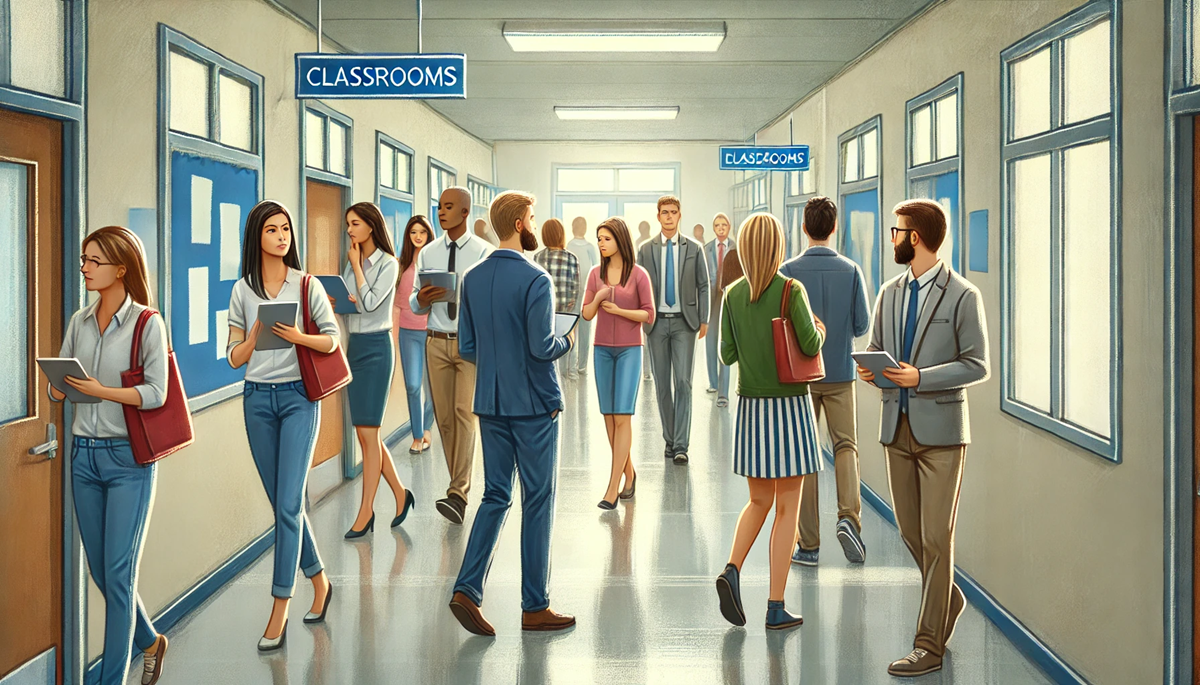One of the main ways that Ensemble Learning works to increase equity for English learners is by convening cohorts of schools who are dedicated to school improvement.
Why do we prefer to work through cohorts and not just individually with each school?
We believe it is important for practitioners to learn and plan alongside “critical friends” who share ideas and provide feedback.
Our cohort members participate in a series of cohort meetings that involve professional learning, time to plan for individual school improvement, and opportunities to provide consultancy and insights to other schools.
In the months following the cohort meetings, schools visit one another’s campuses for what we call “Accountability Events” or school walkthroughs that enable a school to demonstrate the improvements they have put in place and receive further feedback from cohort school colleagues.
These “Accountability Events” are often the place where new learning is solidified.
Whether a school is visiting another school and sees a key English learner instructional practice taking place, or a host school has an epiphany about how to strengthen inclusive classroom culture practices, seeing teaching and learning in action provides an opportunity for deeper learning.

Contents
- 1 Why is it imperative that we open our classrooms and schools to “Critical Friends” and feedback?
- 2 How are “Critical Friends” walkthroughs different from the instructional rounds I might already do at my campus?
- 3 What does the “Critical Friends” walkthrough look like in practice?
- 4 I’m not (yet) in an Ensemble cohort. How can I reap the benefits of “Critical Friends” in my current context?
Why is it imperative that we open our classrooms and schools to “Critical Friends” and feedback?
In my first few years of teaching, I spent many of my open periods sitting in colleagues’ classrooms and informally observing them.
I also opened my classroom to observations from fellow teachers and administrators and asked for thoughts and feedback from them.
While this was sometimes uncomfortable and pushed me to be more vulnerable than I was used to, by opening the door and venturing from my classroom, I struck up conversations about culture and instruction with all types of professionals.
I was a math teacher, but I saw effective strategies in social studies classrooms that I never would have thought to implement. I had conversations with English and science teachers about common literacy strategies that were most impactful, accelerating my own teaching practice (and hopefully the practice of my colleagues).
I share this experience because it demonstrates the benefits of opening up our classrooms and schools to new ideas and feedback and being receptive to learning from the work of others.
If schools operate in isolation, they miss out on the valuable opportunity to gain insights from other practitioners and experts. Our schools have so much room to grow in terms of supporting our highest-need students such as English learners.
We owe it to our students to seek out schools that are implementing strong practices to increase equity and learn from one another.
How are “Critical Friends” walkthroughs different from the instructional rounds I might already do at my campus?
It’s important to note that there are some key similarities between these two types of walkthroughs.
Take a look at this past Ensemble blog post about high-quality instructional walkthroughs.
Specifically, ensuring there is a focus for the walkthroughs and a protocol for the debrief will make sure the time is well spent and impactful on school culture and instruction.
A “Critical Friends” walkthrough is different mainly due to the participants (external visitors) and the overarching purpose (both providing feedback to the host school and sharing practices with external visitors).
In the design of the walkthrough debrief, it is important to allow time for guests to provide feedback to the host school and an opportunity for participants to crystallize what they observed, learned, and will take back to their own schools.

What does the “Critical Friends” walkthrough look like in practice?
When we host these walkthroughs, we spend about half a day on a campus.
We begin by setting the focus for the classroom observations and allowing the host school to share some context about their journey. They tell the participants what they are working to improve, what they have implemented so far, what’s going well, and where they are struggling.
This context enables participants to focus more deeply on the work the school is doing rather than rehashing ideas that have already come up.
Next, all participants (including hosts) walk through classrooms, specifically looking for evidence connected to the school’s improvement efforts. After visiting all classrooms, participants have some personal processing time to compile their data and observations.
We wrap up the day by engaging in a debrief protocol that contains these components:
- Brights Spots and Bright Trends: Everyone (hosts and visitors) shares evidence of strong instruction and culture related to the focus area. Specifically, participants share any trends they noticed across classrooms as evidence of school-wide change. This feedback enables the host school to know what they can celebrate, continue, and build on. In addition, external visitors can take these ideas back to their schools.
- Recommendations for Hosts: Each visitor shares one salient recommendation with the host school based on hearing the context and collecting evidence during walkthroughs. These recommendations connect directly to the focus area of the walkthrough to ensure they are relevant and useful for the hosts.
- Host Reflection: The host school leaders share what stood out to them the most and what they will commit to doing next as a result of the “Critical Friends” feedback.
- Visitor Reflection: Each visitor shares one take-away from the day that they will bring to their own school site. This practice ensures the learning is reciprocal.
Having all four components is important, as we always want to emphasize the value of the walkthrough for both the host and the visitor.
We often see visitors taking photos of artifacts or classrooms so they can directly implement ideas back at their sites.
Hosts hungrily collect the notes and data of the walkthrough visitors to ensure they glean every piece of feedback from the day.

I’m not (yet) in an Ensemble cohort. How can I reap the benefits of “Critical Friends” in my current context?
You will need to consider external guests that you could set up a walkthrough with.
“External” does not have to mean completely new to your context; you could consider fellow principals within your context.
Many districts and charter organizations have principals and other instructional leaders walk through each others’ schools periodically.
If your organization does not, consider working with a coach or regional director to see if you could help spearhead this work. If your organization does not have the capacity at this time, consider other professionals you have networked with recently.
Have you attended a regional conference or training and connected with like-minded individuals?
Invite them to your school for a walkthrough, sharing how the practice will both benefit your school as well as their own learning.
When I was still in the classroom, my organization implemented a practice called “Design Your Own PD Day” for teachers.
On a pupil-free day, my colleagues and I visited other schools in our network, observed teachers, and debriefed our observations. Consider planning something similar for teachers and/or administrators in your organization. The first step to starting this work is getting colleagues open to the vulnerability associated with inviting “Critical Friends” into our schools to provide feedback.
Opening up your own classroom or school to external feedback requires courage and vulnerability.
However, this courage is imperative if we are going to create the educational experience that all students deserve.
Katherine Hamilton works directly with the Learning While Leading cohorts with Ensemble Learning. Continue this conversation about “Critical Friends” walkthroughs or reach out to learn more about joining an Ensemble cohort by emailing khamilton@ensemblelearning.org.



